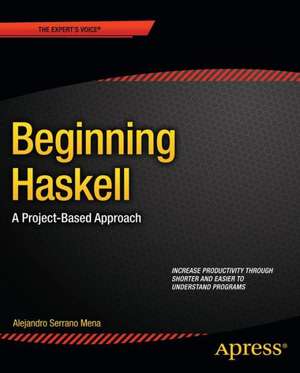Beginning Haskell: A Project-Based Approach
Autor Alejandro Serrano Menaen Limba Engleză Paperback – 23 ian 2014
Functional programming is gathering momentum, allowing programmers to express themselves in a more concise way, reducing boilerplate and increasing the safety of code. Indeed, mainstream languages such as C# and Java are adopting features from functional programming, and from languages implementing that paradigm. Haskell is an elegant and noise-free pure functional language with a long history, having a huge number of library contributors and an active community. This makes Haskell the best tool for both learning and applying functional programming, and Beginning Haskell the perfect book to show off the language and what it can do.
- Takes you through a series of projects showing the different parts of the language.
- Provides an overview of the most important libraries and tools in the Haskell ecosystem.
- Teaches you how to apply functional patterns in real-world scenarios.
Preț: 254.96 lei
Preț vechi: 318.70 lei
-20% Nou
Puncte Express: 382
Preț estimativ în valută:
48.79€ • 52.98$ • 40.99£
48.79€ • 52.98$ • 40.99£
Carte tipărită la comandă
Livrare economică 18-24 aprilie
Preluare comenzi: 021 569.72.76
Specificații
ISBN-13: 9781430262503
ISBN-10: 1430262508
Pagini: 428
Dimensiuni: 178 x 254 x 22 mm
Greutate: 0.73 kg
Ediția:1st ed.
Editura: Apress
Colecția Apress
Locul publicării:Berkeley, CA, United States
ISBN-10: 1430262508
Pagini: 428
Dimensiuni: 178 x 254 x 22 mm
Greutate: 0.73 kg
Ediția:1st ed.
Editura: Apress
Colecția Apress
Locul publicării:Berkeley, CA, United States
Public țintă
Popular/generalCuprins
Part
I:
First
Steps
1. Going Functional
2. Declaring the Data Model
3. Reusing Code through Lists
4. Using Containers and Type Classes
5. Laziness and Infinite Structures
Part II: Data Mining
6. Knowing Your Clients Using Monads
7. More Monads: Now for Recommendations
8. Parallelizing the Execution
Part III: Resource Handling
9. Dealing with Files: IO and Conduit
10. Builders and Parsers
11. Safe Database Access
12. Web Applications
Part IV: Domain Specific Languages
13. Strong Types
14. Attribute Grammars
Part V: Engineering the Store
15. Documenting, Testing, and Verifying
16. Architecting Your Application
Appendix A
Appendix B
1. Going Functional
2. Declaring the Data Model
3. Reusing Code through Lists
4. Using Containers and Type Classes
5. Laziness and Infinite Structures
Part II: Data Mining
6. Knowing Your Clients Using Monads
7. More Monads: Now for Recommendations
8. Parallelizing the Execution
Part III: Resource Handling
9. Dealing with Files: IO and Conduit
10. Builders and Parsers
11. Safe Database Access
12. Web Applications
Part IV: Domain Specific Languages
13. Strong Types
14. Attribute Grammars
Part V: Engineering the Store
15. Documenting, Testing, and Verifying
16. Architecting Your Application
Appendix A
Appendix B
Notă biografică
Alejandro
Serrano
Mena
is
working
towards
his
PhD
thesis
inthe
Software
Technology
group
in
Utrecht
University.
He
is
passionate
forfunctional
programming,
and
has
been
coding
Haskell
for
personal
andprofessional
projects
for
more
than
five
years.
During
his
college
years
he
wasactive
in
an
association
promoting
functional
languages
among
students,
givingtalks
and
helping
programmers
get
started
in
the
functional
paradigm.
In
2011he
took
part
in
the
Google
Summer
of
Code
program,
enhancing
the
Haskellplug-in
for
the
popular
development
environment
Eclipse.
His
current
positioninvolves
research
for
enhancing
the
way
in
which
developers
get
feedback
andinteract
with
strong
type
systems
such
as
Haskell's.
Caracteristici
Beginning
Haskellprovides
a
project-based
introduction
to
Haskell,
its
use
in
creating
domain-specific
languages,
to
ecosystem
elements
such
as
the
Cabal
build
tool
and
the
QuickCheck
testing
tool,
and
to
the
very
latest
libraries
such
as
Conduit
for
data
streaming,
Cloud
Haskell
for
distributed
computing,
and
the
Scotty
web
framework.









